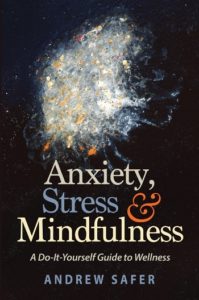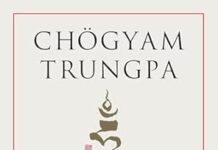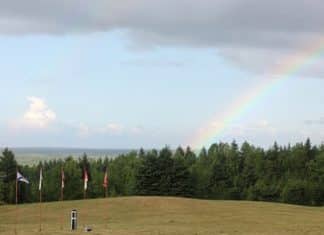
When Andrew Safer left Halifax, Nova Scotia and moved to St. John’s, Newfoundland, ten years ago he brought with him his skill as a writer, his experience in developing self-help programs, and his decades of meditation practice as a student of Chogyam Trungpa, Rinpoche. In 2013 a counsellor in St. John’s, aware that mindfulness practice could be beneficial for people overwhelmed by anxiety, asked Andrew if he could help. The result was an eight-week program entitled “Navigating Anxiety and Stress through Mindfulness”.
In his new book, Anxiety, Stress and Mindfulness: A Do-It Yourself Guide to Wellness, Andrew shares the information that is provided in the eight week program, interwoven with first person reports from people who have participated. The writing is clear and conversational, bringing together everyday experiences and key points that are fundamental to anyone trying to apply mindfulness meditation in their lives, particularly those who do so in hopes of being better able to manage their own anxiety.
From the start it is made clear that meditation is not a quick fix. The opening section (About this Book) includes the following:
Developing mindfulness and awareness isn’t quick, which makes it counterintuitive in our instant-results culture. And, contrary to what you might expect, you won’t be ticking of boxes that say, “Got rid of anxiety and stress”, “Achieved a permanent state of bliss”, and “Now I can banish my negative thoughts and make my mind go blank”. Rather than searching for solutions to problems, we will be doing something radical: simplifying, grounding ourselves, exploring openness, glimpsing our habitual patterns, and waking up to the freshness of the moment — over and over again. We might find that some of our problems are addressed through this process. A rising tide lifts all boats.
The honest, practical and profound nature of this introduction reflects, in my view, the influence of Chogyam Trungpa. It stands in contrast to the constant drone of promises that seem to emanate from some sources these days, as mindfulness has become popularized and commercialized.
The chapter entitled “Uncovering Basic Goodness and Sanity” draws directly from the Shambhala teachings of Chogyam Trungpa. In a section called “Discovering what we’ve always had”, the role of meditation is put in perspective:
Sometimes, the term “basic goodness” is used to describe our basic nature, which includes capabilities for kindness and compassion, insight and openness. It’s our bedrock that doesn’t depend on anything else. Everyone has it. Mindfulness practice doesn’t create this goodness; it helps us disentangle from habitual patterns and self-centered-ness so we can begin to experience things the way they really are. Having some connection to basic goodness means that we can begin to appreciate ourselves, including our ifs, ands and buts. This appreciation can develop, over time, through the practice of meditation.
Another section of the same chapter, called “Bad Seed”, addresses the self-criticism that is rampant in western culture and of particular relevance for those who are struggling with high levels of anxiety and the accompanying social dysfunction. Mindfulness is presented as a way of examining our belief that we are bad and beginning to see those thoughts as passing events, and not who we are. In this context the author recalls his experience working with youth at risk and how these kids were often considered as bad and yet, when given some support, turned out to be amazing young people. Once again Chogyam Trungpa Rinpoche, from The Sacred Path of the Warrior, is cited:
“The failure to appreciate the resourcefulness of human existence – which we call basic goodness – has become one of the world’s biggest problems” wrote Chogyam Trungpa. When a flower isn’t growing properly we don’t say: “That’s a bad flower – get rid of it”. We feel the earth, and if it’s dry, we water it. We don’t give up on flowers, or people.
The sense of not giving up on people seems to permeate the work that Andrew Safer has done in making mindfulness awareness practice available to people experiencing intense anxiety. Listening to Andrew talk about this book, and the work it represents, at the recent book launch in Halifax, it was obvious that he is fully dedicated to working with, and learning from, the people who participate in his programs.
As well, several people at the book launch commented on their experience of Andrew as a remarkably humble, gentle and thoughtful human being. Those personal characteristics no doubt have been a key to the way people in Newfoundland have come to love and appreciate him; asking him to share his unique skills and experiences in order to help those is in need.
That sense of caring and mutual respect is well represented in this book. The work it presents offers a model of how mindfulness can be introduced in a manner that is both practical and profound. The genuineness of the author and his work is a bright light of sanity in a time of hype.
It is said that when a great teacher passes away it is like a mala string breaking. The individual beads, the students, roll off in all directions. The people of Newfoundland, and the readers of this book, are fortunate that one of those beads rolled into St. John’s.
















